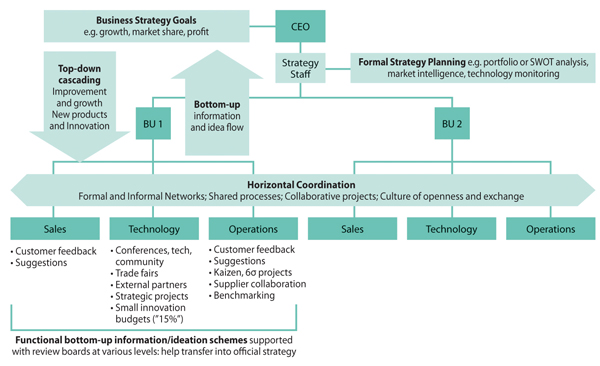By Christoph Loch and Stelios Kavadias
Many top level executives are still hopelessly behind when it comes to designing an effective innovation strategy in the digital age. Below, Christoph Loch and Stelios Kavadias outline the ways in which organisations can effectively outline and implement innovation strategy.
What is Innovation?
Joseph Schumpeter defined it succinctly: innovation is “the commercial exploitation of new ideas.” This idea of innovation refers not only to new products or services, but also to new processes (such as Toyota’s production system), new structures (for example Innocentive’s open market for idea development), or new ways of approaching and interacting with customers (Uber’s novel business model for car hire). Clearly, innovation is possible in all aspects of conducting business.
Organisations innovate in a number of ways: via small steps of modification and improvement (for example, in six-sigma improvement projects or quality circles in operating departments); via larger steps by making significant improvements and updates to their products and services (this is where most of the officially declared Research and Development [R&D] money goes); and, rarely, by attempting radical innovation using revolutionary technology or entering totally unknown markets.
While the risks vary – radical innovation is much more expensive and more likely to fail – all innovation is characterised by inherent uncertainty. Indeed, innovation is an “evolutionary system” analogous to biological and cultural evolution. This means that an organisation needs to produce many diverse ideas (most of which won’t work), in order to capture the few that have the potential to become new offerings and improvements. As the Nobel-winning chemist Linus Pauling declared, “The best way to have a good idea is to have a lot of ideas.”
[ms-protect-content id=”9932″]All innovative systems exhibit three fundamental steps: a mechanism for diverse idea creation (not from one source but from many, most of which are normally located outside the organisation); a mechanism (following initial deliberation and testing) to select the most promising ones; and a mechanism to elaborate, to make an idea work and improve ideas that are being pursued.
Whether innovation happens in R&D, marketing, or in operations departments, these steps are present somewhere – otherwise no innovations can be produced.1 However, high performance innovation systems not only have these three steps but also exhibit alignment and coordination that enable the steps to work in sync.
Innovation Processes
Thomas Edison quipped that “innovation is 99% transpiration and 1% inspiration” – and so it is rational that companies use process to carry out innovation. Creating a standardised way of doing things enables them to do things repeatedly with some reliability rather than leaving outcomes to chance and individuals.
The idea of combining standardisation and innovation seems oxymoronic and points to the difficulty of crafting innovation processes within organisations. However it is possible. Based on the widely documented experiences of a number of organisations, successful processes can be structured into two fundamental types, top-down and bottom-up (see Figure 1). Top-down processes start with the strategy (e.g., identified target markets or competitive threats), then they derive innovation goals, which are prioritised in innovation portfolio tools, fed with structured creativity exercises (possibly bringing in design consultants from the outside) and executed with formal process steps. An archetype of these types of processes is the widely used stage gate process.
Figure 1: Top-Down and Bottom-Up Innovation Processes
Top down processes are suitable for what we can broadly call “next step” innovation, that is the systematic improvement of what we do now, fixing strategic weaknesses that we can see now. Their danger lies in insufficient renewal – senior executives are usually not chosen for creativity but for delivering results now, and they may not be informed about the newest market or technology trends. For example, the current generation of CEOs does not understand social media and how it changes the behaviour of consumers (the authors include themselves in this diagnosis!).
A well-known example is Xerox, a company that had a famous research unit, PARC, the Palo Alto Research Center. It was established top-down to develop technologies in target domains, but then took on a life of its own, becoming bottom-up and sparking ideas such as the PC, the graphical user interface, distributed computing, and many other technological opportunities all slightly outside Xerox’s core business.
However, Xerox adopted a narrow view of its business and strategy rejecting breakthrough ideas from PARC. At the end of the 1990s, Xerox fell into a deep crisis and was restructured because its business had become outdated and had shrunk. PARC was closed just after the turn of the century, with other companies benefiting from the ideas (among them Apple and many other Silicon Valley high tech companies), but not Xerox, because management viewed the strategy of the company too narrowly.
The second innovation process archetype, bottom-up, is the generation of new ideas from employees that go beyond or even against current strategy. This is the dominant model for process improvements in service and manufacturing operations, where all the detailed knowledge is with frontline employees, who can be motivated to share their ideas for numerous small improvements of current operations (for example, through total quality management and continuous improvement methodologies). Companies who do this well can achieve annual productivity improvements in the order of 10% which is potentially a huge competitive advantage.
Bottom-up innovation can also produce business-changing innovations.2 For example, the sweetener Aspartame arose from accidental results of a chemist in the Searle Labs, which, after their ultimate success prompted Searle to shift its business from pharmaceuticals into consumer products. Post-it Notes ended up changing 3M’s business in the 1980s, but were introduced on the stubborn initiative of a few people (led by Art Fry) against strategy and marketing analyses. Even the fundamental re-orientation of IBM in the 1990s from a hardware company, selling services as add-ons, into a services company with hardware divisions as internal suppliers, was initiated by a proselytising middle manager who ultimately convinced management that this was the best (although risky) way to go (the management team still deserves the credit for adopting the new strategy). Similarly, the fundamental strategic shift of Intel away from memory microchips towards microprocessors was sparked by their middle management, which led a bottom-up redefinition of their product lines and innovation projects to support microprocessors.
Of course, these two approaches to innovation are not mutually exclusive. On the contrary, companies who succeed in innovation often follow both approaches in parallel. Indeed, an organisation needs to balance direction with the mobilisation of diverse ideas from many sources. For example, we found in a recent study of manufacturing organisations that a full 50% of strategic projects directly supervised by the top management team (representing, on average, just 15-20 projects per company) had been generated through a bottom-up process.
Many organisations underestimate how messy combining these approaches can be. They throw full support behind innovation efforts, but fail to appreciate that they will have to give up a bit of control – an innovative company will, out of necessity, do things that the CEO does not understand and (sometimes) does not even like. Therefore, in many organisations, a significant part of the innovative energy suffocates from control efforts by top management. Figure 2 shows the “cauldron” of innovative activities in an organisation.
Figure 2 shows a stylised organisation chart, with a CEO office at the top, business unit heads in the middle, and operational heads (implicitly with their operational staff below) at the bottom. The cascading of the strategic direction of innovation efforts happens via business goals articulated at the top (supported by typical tools, such as trends and market intelligence, by their staff). Top management sets goals for the business unit heads, who in turn set goals for their organisations and execute innovation processes with budgets and staff. Thus, we see typical structured top-down innovation.
Figure 2: Multiple Initiatives Enabling Top-Down and Bottom-Up Innovation
But at the same time, employees are allowed to spend time and money on many efforts that create ideas at their level, harnessing ideas from the outside (such as customers, suppliers, trade association activities) as well as performing problem-solving not only for current business but also for the future. For example, this includes quality circles and six sigma projects, but also ideation workshops and some free experimentation (like the 15% unguided time rule pioneered by 3M). This can include, for instance, ideas from blue collar employees to introduce a new paint shop technology, or from service employees with ideas for new processes, offering new services to customers, or listening to customers in different ways. Contributions from employees can (with appropriate selection) make innovation better because they increase the organisation’s total creativity.
This coexistence of top-down and bottom-up activities works only if two fundamental enablers are present. First: trusted organisational help for proposing and, through evaluation and approval, entering employee ideas into the official innovation portfolio and budget. This needs to happen not in one centralised place (which can become a stifling bottleneck) but through resourcing small-scale experimentation and testing at multiple decentralised levels, before a few projects rise up to “strategic” projects that are seen by the CEO office. Indeed, as we mentioned earlier, 50% of strategic innovation projects seen by the CEO may come from bottom-up ideas, and in some companies, even blue-collar workers spend significant chunks of their time (in the order of 30-40%) on improvement activities rather than on today’s production.3
Second: the innovation dynamics shown in Figure 2 can only contribute to effective output through horizontal communication and collaboration. This needs to be supported by an explicit “alignment of goals” (everyone understands how they fit into the larger business and complement one another), by common processes and standards that make explicit how the various actors influence one another, so they can adapt their actions and innovation initiatives to be sensitive of the goals and needs of the others. This includes informal elements, such as rejecting a “lone cowboy” mentality and instead keeping colleagues informed as part of a culture of communication and negotiation of compromises.4
A Hard Look at Innovation Strategy
This desired balance between top-down and bottom-up innovation processes, gives rise to the question of what role innovation strategy can play in such a partially chaotic organisational system.
The first principle that senior management should adopt is that innovation strategy must be a core part of business strategy. Business strategy defines a competitive position (what offerings, to which customers, with what fundamental value proposition, through which combination of internal activities and external supplies), but the strategic proposition needs to evolve over time as the environment changes – in most industries, the half-life of strategies has shrunk to three years or less. In this respect, innovation strategy should address the dynamic character of strategic positioning.5
A second principle requires a shift in mindset: an evolving strategy cannot fully be planned. Of course, senior managers need to plan, but they also need to realise that large pieces of “the plan” maybe no more than hypothesis. Evolving the strategy is a journey where planning helps you to diagnose where you are and to understand the direction of travel, but it is not an “optimised planned change”. This means that innovation is a core part of evolving an organisation’s strategy over time.
Strategy is a journey through a dynamically evolving competitive landscape. Senior management teams who believe that they personally hold all the knowledge required to steer the organisation through a changing world will sooner or later be caught out. They need to proceed with provisional plans, knowing that these plans may have to change as developments in the environment emerge. Management teams need intelligence and room for creativity within the organisation, as well as without, in order to make good decisions in this journey.
When you look at the strategy journey through this lens, the cauldron shown in Figure 2 suddenly changes from a hard-to-control mess to a great opportunity to generate the inputs for good strategic decisions. Senior managers need to embrace the messiness of bottom-up ideas as a source of help to be able to steer the boat.
We can translate this conclusion into tangible recommendations for the behaviour of top managers in treating the innovation system of the organisation:
• It is top management’s responsibility to set a strategic direction. However, strategy is a journey, and because of the complexity and unpredictability of the environment this journey contains surprises, experiments, and changes in course. So a mindset of experimentation with some of the elements of strategy is required—sometimes similar to the pivoting strategic choices that small entrepreneurial start-ups make.
• Innovation is not only the shoring up of the organisation’s business (“new product development”) but a core dimension of business strategy. Therefore, top management should define a portfolio of innovation activities not only to support the current business, but also to support the strategic journey: innovation should explore responses to environmental changes, including business models, customer approaches, approaches of regulators, and so on – anything that is viewed as uncertain or changing in the business environment.
• Any strategic plan is not an end in itself but only a hypothesis. Therefore:
1. Delegate execution (sharpen it with good ideas from below).
2. Get as many ideas as possible from the outside, and then morph them to become useful to your key strategic uncertainties.
3. Define/earmark resources for new ideas that go beyond strategy, across departments (tech, products, processes, customers, business models).
4. Evolve business strategy every year with input from the entire organisation.
5. Set goals for all parts of the organisation not only for current efficiency and new products, but also for renewal in the spirit of addressing the changing environment.
About the Authors
 Christoph Loch is the Director of Cambridge Judge Business School at the University of Cambridge. He is also a Professor of Management at the School. Professor Loch’s research interests include innovation in products as well as processes and practices and managing novel initiatives; as well as innovation strategy and strategy deployment.
Christoph Loch is the Director of Cambridge Judge Business School at the University of Cambridge. He is also a Professor of Management at the School. Professor Loch’s research interests include innovation in products as well as processes and practices and managing novel initiatives; as well as innovation strategy and strategy deployment.
 Stelios Kavadias is a Director of Research and the Margaret Thatcher Professor of Enterprise Studies in Innovation and Growth at the Cambridge Judge Business School. Professor Kavadias’ research interests include, but are not limited to, the effectiveness of new product development with a particular focus on strategy implementation and R&D ideation.
Stelios Kavadias is a Director of Research and the Margaret Thatcher Professor of Enterprise Studies in Innovation and Growth at the Cambridge Judge Business School. Professor Kavadias’ research interests include, but are not limited to, the effectiveness of new product development with a particular focus on strategy implementation and R&D ideation.
References
1. Loch, C.H., S. Kavadias. 2007. Managing New Product Development: An Evolutionary Framework. Chapter 1 in: Loch, C. H. S. Kavadias (Editors). Handbook of New Product Development Management. Oxford: Butterworth Heinemann Elsevier.
2. Loch, C. H., S. Kavadias. 2011. Implementing Strategy Through Projects. Chapter 8 in: Morris, P., J. Pinto and J. Söderlund (eds.), The Oxford Handbook on the Management of Projects. Oxford: Oxford University Press, pp. 224-251.
3. Kim, Y. H., F. J. Sting, C. H. Loch. 2014. Top-Down, Bottom-Up, or Both? Toward an Integrative Perspective on Operations Strategy Formation. Forthcoming, Journal of Operations Management.
4. Loch, C. H. 2008. Mobilizing an R&D Organization Through Strategy Cascading. Research Technology Management, September–October, pp. 1-9.
5. Markides, C. C. 1999. A dynamic view of strategy. Sloan Management Review, Spring, pp. 55-63.
[/ms-protect-content]






























